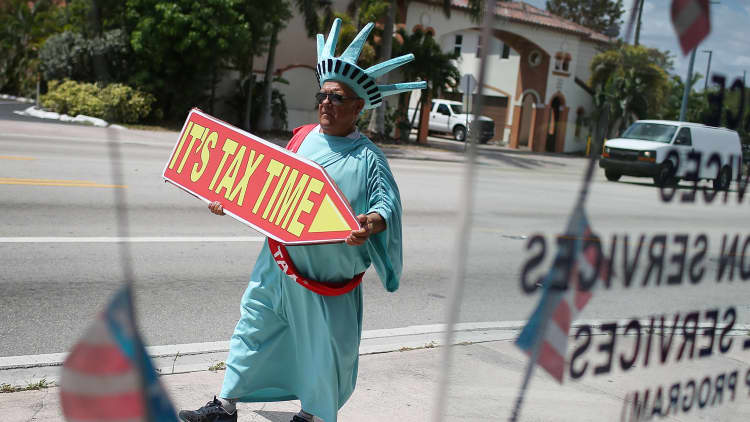
Note to early income tax filers: Keep an eye on your mailbox and your email. Everything you need to submit your return should be on its way.
Filing season for 2016 kicks off on Jan. 23 and runs until April 18 (that's right, you get three extra days to file this year). In all, Uncle Sam expects to receive more than 153 million tax returns this year.
The reason the deadline to file 2016 returns and pay any tax due is April 18 is because the traditional April 15 deadline falls on Saturday this year and the Emancipation Day, a holiday in Washington, D.C., is observed on April 17.
Bear in mind that while you can submit your return early, the IRS will delay refunds for those who claim the earned income tax credit and the additional child tax credit until Feb. 15. Those taxpayers may not have access to their cash until Feb. 27 because a new law requires the IRS to hold on to the entire refund for those filers in order to deter fraud.
This year, you might require more than just a W-2 from your employer to square away your taxes, especially if you had health-care coverage or if you earned some money with a side gig.
"A lot of people are in the sharing economy and getting money from Airbnb and Uber," said Cari Weston, director of tax practice and ethics at the American Institute of Certified Public Accountants.
"If you're doing these activities, anticipate a 1099-MISC or a 1099-K," she said.
Here's a breakdown of the forms you may receive before you file your taxes and when you can expect to get them.
Key forms in January
Employers must provide employees with a W-2 by Jan. 31.
Similarly, businesses that hire independent contractors will have to give them their 1099-MISC by that date, which will include information regarding nonemployee income.
If you're an independent contractor, you should be tracking your income throughout the year.
"Be proactive and contact companies to find out when they're issuing those 1099-MISC forms," said Gavin Morrissey, managing partner at Financial Strategy Associates in Needham, Massachusetts.
Workers aren't the only ones who need to watch their mailboxes. Every January, the Social Security Administration sends beneficiaries an SSA-1099, which will detail what they received during the previous year.
If you blink, you may miss your 1099-R, a document filers get when they've taken a distribution from a retirement plan or from an IRA. Expect your brokerage firm to send this out to you by the end of January.
"People tend to miss the 1099-R in the first year they take a distribution from a plan, or if they've inherited an IRA and they're required to take a distribution," said Debbie Freeman, director of tax and financial planning at Peak Financial Advisors in Denver.
Early to mid-February
You may have heard about the triple tax benefits of a health savings account: You can make tax-deductible or pretax contributions to it. Also, your money will grow free of taxes and you can use the cash tax-free for qualified medical expenses.
If you tapped the HSA in 2016, then the bank administering your account will send you a 1099-SA by the middle of February.
Further, if you had insurance coverage last year, whether you bought it through a state or federal marketplace or you had it at work, you'll get a Form 1095-A,-B or-C by mid-February.
Owners of taxable accounts also need to be on the lookout around mid-February for a slew of 1099s from their brokerage firms. These forms report dividends and interest of more than $10, as well as capital gains and stock sales.
If you itemize deductions, watch out for Form 1098, which you'll need to deduct mortgage interest.
You can also deduct tuition and education costs and student loan interest that's more than $600 with forms 1098-T and -E, respectively.
Chase these forms down
Investors in partnerships, as well as recipients of a trust or estate, may have to sit tight all spring while waiting for their Schedule K-1, which reports income, losses and dividends.
These individuals may have to estimate their income and taxes, and then request an extension with the IRS.
"If you're a shareholder in my S-Corp, and you need a K-1, I can't send it to you until I finish my return," Weston said. This becomes even more complicated if the S-Corp itself needs to file an extension.
You'll need to do a little legwork to get other forms. For instance, you'll need to ask your child care provider for additional documents if you'd like to claim the child and dependent care credit.
Further, though an ex-spouse who pays alimony can claim a deduction for it — and the recipient must recognize it as taxable income — neither will receive documents that they can use on their taxes.
"You'll have to go back to your records and review the payments," Freeman said. "They should match the divorce decree."


